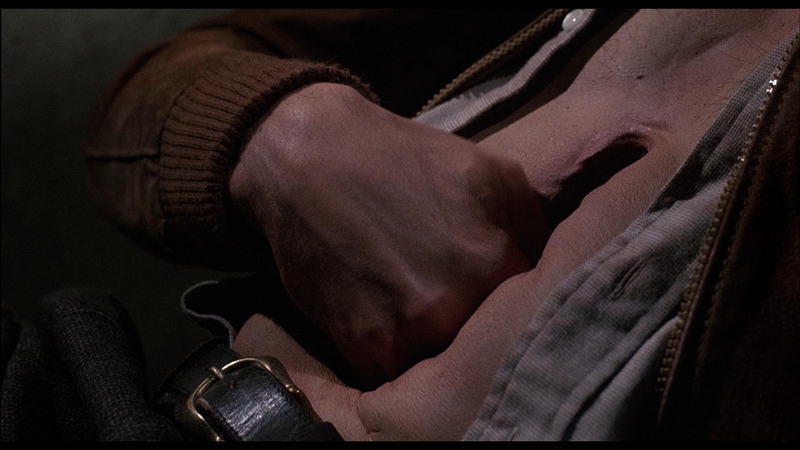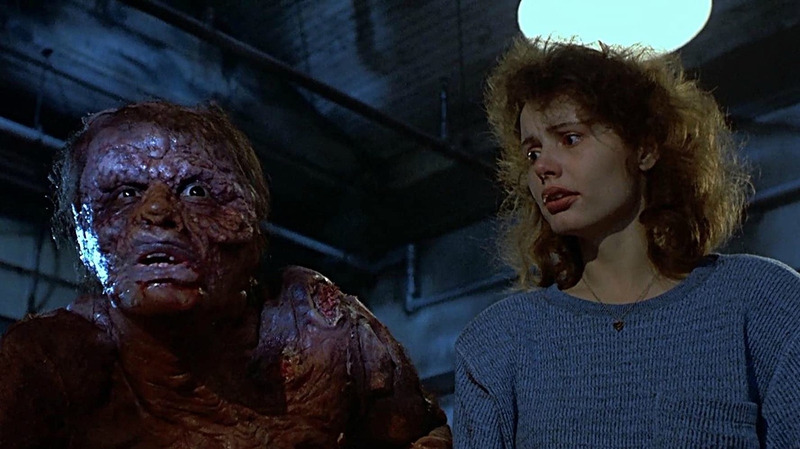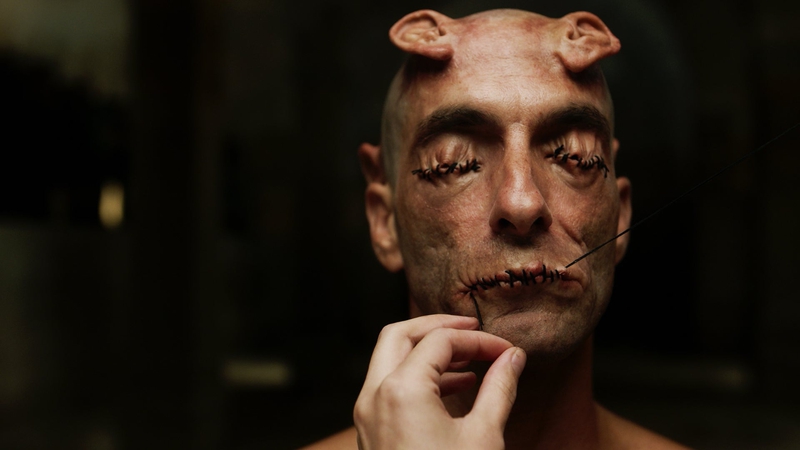"Cronenberg's best movies still have the capacity to cause a sort of Jungian culture shock. They're like Bunuel, or Francis Bacon: wit and trauma, savagery and pity. Within what for most people is a very restrictive genre, Cronenberg has come up with a genuinely original vision. Internal metaphors, external horror." ― Martin Scorsese
In 1984, FANGORIA presented Martin Scorsese's brief essay from David Cronenberg's retrospective at the Toronto Film Festival. "Haunted and hounded" by the Canadian filmmaker's work, Scorsese's words, almost 40 years later, only remind us how much a very particular filmography has lost none of its potency. Now, in marking Cronenberg's 80th birthday, we celebrate a subgenre he defined and explore some of the themes that have manifested in body horror… these "ways of the flesh." Such a term sparks religious connotations, so there is some irony that as an atheist — seeing such beliefs as a destructive philosophy — Cronenberg has never been one to lean towards these trappings. This includes the inherent medievalism, often steering away from traditional horror that taps into God, heaven, hell, and satanic mythology. Instead, he leans into European sensibilities; his love of modern literature naturally links him to the Kafkaesque and Ballardian attitudes embedded within his work.
This has often grounded his horror and fed into how modern his films remain through a keen sense of observation, often twisted and contorted beyond belief. Cronenberg's monsters, therefore, remain intangible — despite their obvious biological influence — avoiding specific trappings we would associate with traditional horror, while the stories he tells remain visceral, horrific, and, indeed, terrifying, lacing his narrative with a strange sensitivity. This isn't to say there are no gothic tropes and conventions at all — his stories are full of mad scientists, enclosed spaces, death, and perversity — but what he has always done is embrace a clinical approach primarily influenced by his interest in the sciences. All of this dates back to his academic years in organic chemistry — dissecting his fair share of fetal pigs — before moving on to study literature, his distinctive approach to horror making all the more sense.
As a Canadian, Cronenberg not only dissects, he observes through a microscope. He has always remained the outsider looking in… and inside. While he may be scrutinizing how (our) skin crawls, he may also remind us of a strange neighbor who peers into the chasm of chaos that unfolds next door and discovers something far more sinister than himself. Amongst the pustule growths and exploding heads — reminiscent of the violence and horror of America — there are the subtle emotions that are just as destructive. We may be repulsed by the body horror at the core of his storytelling but it is only the physical manifestation of less tangible and more psychological aspects played out on screen. As touched upon already, it is unavoidable not to think of Franz Kafka's work — the paranoia, isolation, and bureaucracy — that only enriches his work, coupled with those Freudian and Jungian theories. [1]
Sex and divorce
Like a doctor or a scientist who probes and reveals what may remain dormant inside all of us, Cronenberg's ideas (most terrifyingly) are based on "things" that cannot be removed; his narratives injected with something grotesque and invasive. His early work of the '70s — Shivers and Rabid — predated the parasitic horror of Ridley Scott's Alien, the extraterrestrial themes of this period less about the tiresome Red Scare propaganda and, instead, more about the enemy "from within."

Much like some critics at the time, it would be easy for most to dismiss his work from this era as merely exploitation pieces. An underlining intelligence set his work apart from the soft porn of Canuxploitation, delivering narratives more in line with the works of J.G. Ballard, whose 1973 novel Crash he would later adapt [2]. Shivers predates another Ballard novel, High-Rise; both works set in ominous-looking architecture housing a bureaucratic system resulting in the disintegration of society.

In Shivers, the modern tower blocks are the perfect microcosm for a stark observation of society and the conformist attitudes of the time. This approach can be seen as tenuous but is part of what distinguishes Cronenberg's films as something equally pervasive, transgressive, and subversive; flesh the perfect canvas to project anxieties and social commentary. Here the isolated class system (and its hierarchy) are reduced to thoughtless sex maniacs when a parasitic worm infects them; a concept that under most other directors could have turned into a Corman-Meyer pastiche, but became the beginning of Cronenberg's innovative and shocking style. Despite Shivers becoming the most profitable film in Canada up to that point — shot on a $185,000 budget and financed by tax breaks from the Canadian government — it was deemed too controversial by the Parliament of Canada, disputing the artistic value and potential impact on society with its sexual and violent content. Censorship and Cronenberg go hand in hand.
Both Cronenberg and producer Ivan Reitman — who would later find commercial success with the classic goofball capers, Ghostbusters and Twins — were to push the explicit nature of their first film even further when Reitman, visiting New York, had caught a late-night underground TV show with porn star Marilyn Chambers as a naked guest. He immediately called up Cronenberg with an idea and Rabid was born with Chambers as the lead. It tells the story of a woman who survives a car accident… but, after her emergency plastic surgery, she turns into a vampire-like creature — substituting the traditional fangs with a savage phallic appendage under her armpit that turns everyone into zombies.

Cronenberg would go on to release two films in 1979: the drama Fast Company — an ode to his obsession with cars — and (arguably) his most personal work that arrived in the shape(s) of The Brood. Based on his acrimonious divorce, his use of body horror became the psychoanalysis for a broken marriage and, more devastatingly, broken children. Much like Andrzej Żuławski's Possession — the Polish director's own divorce therapy — both films often parallel each other, including indefinable "births" and the monstrous female. The Brood could be seen as somewhat restrained compared to Żuławski's hybrid nightmare, yet it remains disturbing in its own right. Once the true horror is revealed, it explicitly illustrates the "messy" procedure surrounding a failed relationship; emphasizing how the body is used to convey an underlying message. The winter setting only adds to an already chilling and foreboding atmosphere before its "little" eruptions of classic horror. As with all of Cronenberg's films, in The Brood, domesticity doesn't exist. Instead, it is replaced by something far more sterile, sinister, and deeply unsettling, only highlighting how his early works never fail to crawl under our skin.
Media and technology
After his iconic (head-exploding) Scanners came Videodrome, exploring how much media technology has an impact on human senses (and our desires). Cronenberg flips this strange fascination with horror, sex, and violence — not just the home invasion of media but also a physical invasion that asks where those boundaries of reality and consciousness lie… and lies. This is as close to the writings of Marshall McLuhan as one could get, Cronenberg's very own "inventory of effects"; the mysterious media theorist (or TV prophet) Brian O'Blivion modeled on McLuhan himself. With Rick Baker on the make-up effects, this is a film full of remarkable and definitive Cronenberg imagery, from James Woods' hand merging with his gun to the pulsating videotape pushed into his vagina stomach (or torso tape player), "I've got something I want to play for you." Then there's "the mouth" by way of Debbie Harry's beckoning visage projected on a throbbing television set, "Come to me… come to Nicki", she whispers as he caresses and pushes his head into the screen. It brings a whole new meaning to "turning on the TV."

This meld of the organic and the mechanic was later seen in eXistenZ, another weirdly erotic sci-fi/horror that explores the fear of the body being penetrated — Jude Law and Jennifer Jason Leigh caressing portals and licking each other's control sockets — but succeeds more during its grotesque interludes. By the very nature of the film, this is Cronenbrg's exploration of the existential that treads similar ground to Videodrome. It is so close, in fact, that it feels like a semi-sequel as the central characters fuse with their technology — a VR control unit — and construct another freakish weapon; the gristle gun, which is a sickening amalgamation of skin, bone, and teeth made from the leftover food on their dinner plates. Once again, despite Cronenberg's visceral imagery, his underlying philosophy at this point in his career starts to claw its way to the surface where the terrifying idea of being taken over or controlled has never been so literal.
Returning to familiar territory in his 2014 novel Consumed, Cronenberg delivers the detailed voyeuristic body horror we have craved as a couple of globetrotting freelance journalists become entangled in a French philosopher's death that sparks a surreal, global conspiracy. Cronenberg waited for just the right time to unleash the novel — Videodrome for the social-media age — a story that thrives on pure technolust and hardware fetishism that devolves into those darker metaphors synonymous with his work. This is consumption as a modern disease more closely linked to consumerism as cannibalism.
Love and loss
Surrounded by walls of books in his childhood home, the young Cronenberg developed a natural appetite for reading. Both his parents were involved in arts and literature — his father a bookstore owner and columnist for The Toronto Telegram, his mother a piano player with the National Ballet — a relatively normal upbringing for an individual steeped in such weird and perverse imagery. However, in the mid-'70s, his father fell fatally ill, a mysterious disease affecting his bones, becoming so fragile he would break a rib turning in his sleep. His mind was there, but his body had failed him. With all of this in mind, having watched his father literally fall apart before his eyes, some would say there is an unhealthy relationship between the filmmaker and his themes. Nevertheless, he has always wished for his body horror to remain on the screen, as he told The New York Times in 2005: "If you admit to the possibilities of the most horrific things, then maybe they won't happen. It's what I do when I make movies. You're hoping it's going to stay on the screen and not come into your life."

The experience of losing a loved one isn't uncommon for any artist and is most apparent in Cronenberg's remake (or reimagining) of Kurt Neumann's The Fly. Arguably his most commercial horror film, his '86 version is as reminiscent of a Shakespearean tragedy as it is a mix of Mary Shelley's Frankenstein and Kafka's seminal novella, The Metamorphosis [3]. The perfect fusion of romance and horror, it is also a story that shows the devastating deterioration of the human condition. As Chris Rodley states in his book, Cronenberg on Cronenberg, "The movie achieves a difficult synthesis: of the 'gloopy' side of Cronenberg's work — the obvious trademark of all his features up to Videodrome — with a newly found special effect: an emotional intensity and deep melancholia realized (for the first time in The Dead Zone) through performance … the first movie truly to integrate Cronenberg's evolving concerns and passions."
What works the most is the gradual disintegration of Seth Brundle. Where the original pulls more directly from George Langelaan's short story — first published by Playboy in 1957 — Cronenberg alters the DNA and transports us somewhere else entirely while still managing to retain a genuine love story. Rather than an instantaneous effect, Brundle's gradual transformation into "Brundlefly" becomes more and more grotesque. Instead of falling into the classic tropes and conventions often associated with gothic monsters and mad scientists, Jeff Goldblum's signature eccentricities shape a loveable genius who tragically loses his mind, body, and soul. As a more commercial endeavor, the film was less a comment on the AIDS epidemic — Cronenberg resistant to this analogy — and more on our mortality [4]. "It's a compression of any love affair that goes to the end of one of the lovers' lives. We've all got the disease — the disease of being finite. Death is the basis of all horror."
A distinct fear of loss — loss of the body and a loved one — is transformed into something more gruesome and terrifying. As David Thomson highlighted in The New Biographical Dictionary of Film: "Cronenberg's subject is the intensity of human frailty and decay: in short, the body and its many accelerated mutations, whether out of disease, anger, dread, or hope." The less tangible he makes it, the more he covers it up in bodily metaphor, an unknown quality reminiscent not just of Kafka's dread and sense of alienation but also of H.P. Lovecraft's paranoia — a writer who was often cynical about potential horrors of scientific advancement — Cronenberg's The Fly a poignant reminder of how playing God never ends well.
Crimes and collaborations
Cronenberg remains a dominant presence on set, but outside of his steely persona, he is both witty and fully engaged with those he collaborates with. Having dabbled in acting — most notably, Clive Barker's Nightbreed and the recent Slasher season Flesh & Blood — he more than understands the process. He is a director who has built strong partnerships with his actors including Robert Pattinson — Cosmopolis, Maps to the Stars — and, most notably, Viggo Mortensen, having worked together on A History of Violence, Eastern Promises, A Dangerous Method, and, most recently, Crimes of the Future. Exploring such intangible worlds and concepts, it has been crucial over the years for Cronenberg to find the right collaborators. In addition to his costume designer sister — the late Denise Cronenberg (1938-2020) — there is production designer Carol Spier; cinematographer Peter Suschitzky and composer Howard Shore; all of whom have continued to work on many of his projects.

At the crux of all of Cronenberg's work is the pain that reminds his characters of whether they exist at all. Even in his thrillers — A History of Violence and Eastern Promises — the intimate horror is displayed in the cold kill or a hot sauna fight. Brutal but alive. In his most recent release, Crimes of the Future — we get a sort of "Cronenberg's greatest hits" — his exploration of pleasure and pain is filtered through ecological themes and human evolution. The film becomes another prime example of how he juxtaposes an implicit concept with explicit imagery, "performance surgery" taking full advantage of a future where pain no longer exists. In this future, the "internal metaphor" as "external horror" Scorsese articulated almost 40 years ago plays as a distinct metaphysical approach [5]. It is both self-referential and a profound sensual experience, questioning the very nature of reality that isn't traditionally set within dreams and nightmares. Instead, it directs our attention toward how one questions "reality" on a physical level.
A Cronenberg horror questions where the body and the flesh end and our true selves begin, enough to blow our fragile little minds. Much like Crimes… as an audience, we are forced to stare into those gaping wounds in the hope that the pain reveals the answers and other potential doorways beyond the natural world where we potentially breach that border through realms of senses; love, telepathy, genetics, surgery, body or gender modification. Ultimately, despite such visceral and unforgettable imagery, what separates David Cronenberg's unique "body" of work from being merely exploitative is how he has always utilized powerful visuals to assist a narrative. This is "horror as art," and the more that is left for us to figure out (or dissect)… the more horrific his films become.






